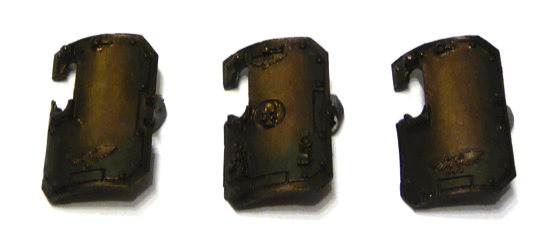Hi folks,
I haven't had much time to myself over the past couple of weeks, so my glacial rate of painting is even slower than usual. Work is back with a vengeance; at the moment I am teaching nuclear chemistry to my seniors and it requires a lot of preparation. Likewise, my social calender is bursting like an over-ripe watermelon. Yesterday I went to a Greek Orthodox Christening which was far more elaborate than my wedding was 10 years ago.
Nevertheless, I have managed to finish the plain siege mantles for my Sternguard (they will be getting a name change soon...). Quite a few people have commented on the corrosion effect I have used, so I thought I would show the technique step by step, in case people want to try it out. Over the past 20 years there has been a big move towards the realistic depiction of weathering and corrosion in the 40K hobby. These days, some miniatures are weathered so much you wonder how they are still functional ;-) The shields start very dark, so bear with me for a while; I have lightened them up as much as I can!
 |
| The real thing: verdigris on ancient Greek helmets |
To begin with, verdigris is a form of patina you can find on copper, or the alloys of copper (such as bronze or brass). Patina itself is a word used to describe any layer that forms on a surface due to exposure to reactive substances in the environment (be they atmospheric or geological), whether it be rock, metal, wood or anything else you can imagine. Verdigris, when it forms near the sea, is usually a layer of copper(II) chloride.
 |
| Copper(II) chloride |
My Iron Snake veterans have a very good reason to spend lots of time at sea (more on that later...), so it is feasible that they would have some verdigris forming on the bronze portions of their armour (let's assume the bronze is purely decorative, I don't see it stopping a bolt gun round).
Before the following pictures were taken, I prepared by siege mantles by undercoating them using Chaos Black spray, followed by a layer of Warplock Bronze. A black wash was gradually added to the left and right edges until the very edge was completely black, with a gradient towards the middle (it gets lighter and lighter). I then dry brushed Warplock Bronze back into this gradient to blur the interface. I mixed some Auric Armour Gold and Warplock Bronze in a 1:1 ratio and drybrushed it on the centre-line of the shield. Again, I drybrushed Warplock Bronze into the gold mix to blur the interface. All of this basically accentuates the curvature of the shield. Next step:
 |
| 3:1 Mournfang Brown/Kabalite Green |
I dull down the bottom quarter of the shield with a 3:1 Mournfang Brown/Kabalite Green mix. Later on in the process I drybrush Warplock Bronze back into this to blur the interface, using circular brush strokes.
 |
| 1:1 Mournfang Brown/Kabalite Green |
I add 1:1 Mournfang Brown/Kabalite Green to about 2/3 of what I just dulled down. To neaten it up, I wet blend the original mix back in.
 |
| 1:3 Mournfang Brown/Kabalite Green |
I add 1:3 Mournfang Brown/Kabalite Green to about 1/2 of what I originally dulled down.
 |
| Straight Kabalite Green |
I drybrush straight Kabalite green over the top, blending in some of the previous mix to neaten it up. You can see the middle shield got a little more than the others, but this kind of inconsistency isn't much of a problem; it could just be an older shield ;-)
 |
| 1:3 White Scar/Kabalite Green |
I drybrush a 1:3 White Scar/Kabalite Green to provide a rough highlight. I knock this highlight back with a Kabalite Green glaze. You can see that I tilted the shields a bit further in this photo and caught the reflection off that Auric Gold on the centre-line.
 |
| 3:1 White Scar/Kabalite Green |
I pick out the extreme edge of the detail by hard-lining with a 3:1 White Scar/Kabalite Green mix. These shields had a couple more hours of detail left before they were finished, but the verdigris at this stage is complete. So there you have it!
Good luck with your own weathering projects; I look forward to seeing them.
See you across the table,
M4cr0


No comments:
Post a Comment